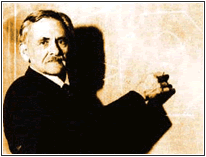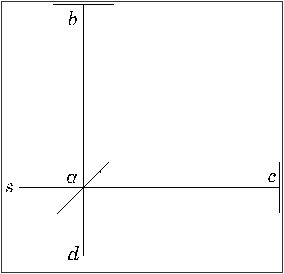
You are here: Home >> History of Light >> The Ether >> The experiment
Scientists believed that the ether did not have mass and was invisible, so it was undetectable by normal chemical and physical means, even though it permeated all matter and all space. Albert A. Michelson, one of the first great American experimental physicists, formulated an experiment in the 1870s to detect the ether by studying its effect on light. His first experiment was made in 1879. For Michelson to detect the existence of the ether was a subject much provoking.
Albert A. Michelson, one of the first great American experimental physicists, formulated an experiment in the 1870s to detect the ether by studying its effect on light. His first experiment was made in 1879. For Michelson to detect the existence of the ether was a subject much provoking.
He made his experiment by placing two mirrors onto the tops of two mountains, mountain Wilson and mountain San Antonio. We now know that in a distance of 22 miles his was inaccurate for almost 50 centimetres! Some scientists believe that it was one of the most accurate experiments ever made. Michelson repeated this experiment more accurately in 1887 with American chemist Edward W. Morley, and the experiment is known today as the Michelson-Morley experiment.
Michelson deduced that the earth must move relative to the ether. The earth moves through space around the sun, so if the ether exists and occupies all space, the earth must move through the ether. Michelson and Morley reasoned that the velocity of a light wave should depend on whether it is moving in the same direction as the ether (opposite the earth's motion) or in the opposite direction of the ether's movement (the same direction as the earth). Light moving in the same direction as the ether should travel faster than light moving against the ether's motion. They based this assumption on the behaviour of other waves - the speed of waves travelling in water, for example, is related to the speed at which the water is flowing.
 The Michelson-Morley experiment separated a beam of light with a special piece of glass, half of which was a mirror, called a beam splitter. Half of the beam of light travelled in the direction of the earth's motion, and half was reflected by the mirror and travelled perpendicular to the earth's motion. Each beam bounced off other mirrors and came back to the beam splitter, where the split beams were recombined into one beam. The length of the path that both beams of light travelled was exactly the same. In the original beam, the crests and troughs of the light waves were all lined up, but if one of the split beams had covered the distance more slowly than the other, the crests and troughs would no longer be lined up when the beam was recombined.
The Michelson-Morley experiment separated a beam of light with a special piece of glass, half of which was a mirror, called a beam splitter. Half of the beam of light travelled in the direction of the earth's motion, and half was reflected by the mirror and travelled perpendicular to the earth's motion. Each beam bounced off other mirrors and came back to the beam splitter, where the split beams were recombined into one beam. The length of the path that both beams of light travelled was exactly the same. In the original beam, the crests and troughs of the light waves were all lined up, but if one of the split beams had covered the distance more slowly than the other, the crests and troughs would no longer be lined up when the beam was recombined.
If the crests and troughs were not lined up, the two beams would interfere with one another, producing a distinctive pattern of light and dark bands. If the beams travelled at the same speed, there would be no interference pattern. Michelson and Morley found no interference pattern, even after rotating their experiment through many orientations and performing the experiment at different times of year. The lack of interference demonstrated that the split beams travelled at the same speed and showed that the speed of light was independent of the motion of the earth. This finding indicated that the ether did not exist.
Related links (external pages)